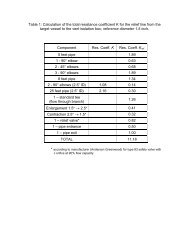The Nu-SNS proposal - ORNL Physics Division - Oak Ridge ...
The Nu-SNS proposal - ORNL Physics Division - Oak Ridge ...
The Nu-SNS proposal - ORNL Physics Division - Oak Ridge ...
You also want an ePaper? Increase the reach of your titles
YUMPU automatically turns print PDFs into web optimized ePapers that Google loves.
neutrons in the 1f 5/2 level. Improved weak interaction rates for electron/positron capture and β<br />
decays on nuclei relevant for stellar evolution (nuclear mass between 45 and 65) have become<br />
available in recent years using shell model diagonalization [27,28]. Heger et al. [29] utilized<br />
these new weak reaction rates to improve upon the stellar evolution simulations of Woosley &<br />
Weaver [30] (WW95). <strong>The</strong> WW95 models used the electron capture rates of Fuller, Fowler, &<br />
Newman [31] (FFN), which estimated the GT contributions based on an independent particle<br />
model parameterization, and older sets of β decay rates [32,33]. <strong>The</strong> most noticeable effect of<br />
these improvements is a marked increase in the electron fraction (Y e ) throughout the iron core<br />
before collapse.<br />
It was suggested that the persistence of these initial differences in Y e throughout collapse should<br />
have a discernible (positive) effect on the shock energetics, because the final size of the<br />
homologous core is proportional to the square of the trapped lepton fraction at core bounce [34].<br />
However, the electron/lepton fraction is greatly modified during the collapse of the stellar core.<br />
<strong>The</strong> increasing density, and concomitant increase in the electron chemical potential, accelerates<br />
the capture of electrons on heavy nuclei and free protons in the core, producing electron<br />
neutrinos that initially escape, thus deleptonizing the core. Thus the location at which the shock<br />
forms in the stellar core at bounce and the initial strength of the shock are largely set by the<br />
amount of deleptonization during collapse. Figure 3.2 summarizes the thermodynamic conditions<br />
throughout the core at bounce and displays the temperature, electron fraction (Y e ), electron<br />
chemical potential (µ e ), and mean electron neutrino energy (E νe ) in MeV as functions of the<br />
matter density. Also shown is the representative nuclear mass (A). <strong>The</strong> kinks near 3×10 7 g/cm 3<br />
mark the transition to the silicon shell. Deleptonization would be complete (Y e ~0) if electron<br />
capture continued without competition, but at densities of order 10 11-12 g/cm 3 , the electron<br />
neutrinos become “trapped” in the core, and inverse neutrino capture reactions begin to compete<br />
with electron capture until the reactions are in weak equilibrium and the net deleptonization of<br />
the core ceases on the core collapse time scale. <strong>The</strong> equilibration of electron neutrinos with<br />
matter occurs at densities between 10 12-13 g/cm 3 .<br />
As the densities increase, the characteristic nuclei in the core increase in mass, owing to a<br />
competition between Coulomb contributions to the nuclear free energy and nuclear surface<br />
tension, until heavy nuclei are replaced by nuclear matter for mass densities near that of the<br />
nucleons in the nucleus (~10 14 g/cm 3 ). For densities of order 10 13 g/cm 3 , nuclei with mass ∼100<br />
dominate. Figure 3.3 demonstrates that the nuclear composition during stellar collapse shows a<br />
wide spread in mass (species with significant concentrations have masses that differ by 40 mass<br />
units) and that the abundances of nuclei with mass greater than 100 are significant as early as<br />
10 11 g/cm 3 . Fuller [36] realized that electron capture on heavy nuclei would soon be quenched in<br />
the picture of Bethe et al. [26], as neutron numbers approach 40, filling the neutron 1f 5/2 orbital.<br />
Calculations using the independent particle model (IPM) showed that neither thermal excitations<br />
nor forbidden transitions substantially alleviated this blocking [36,37]. For many years, this<br />
prescription was widely adopted in core collapse simulations (see e.g. [8]), leading to a higher<br />
rate of electron capture on protons than on heavy nuclei during collapse.<br />
ν-<strong>SNS</strong> Proposal 20 8/4/2005



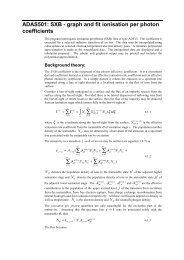

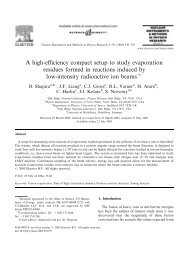
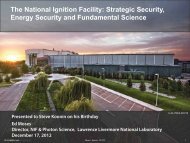

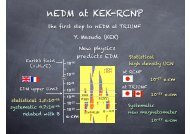



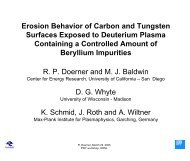
![Mixed-mode Calculations within the Nuclear Shell Model [pdf]](https://img.yumpu.com/28265410/1/190x146/mixed-mode-calculations-within-the-nuclear-shell-model-pdf.jpg?quality=85)

